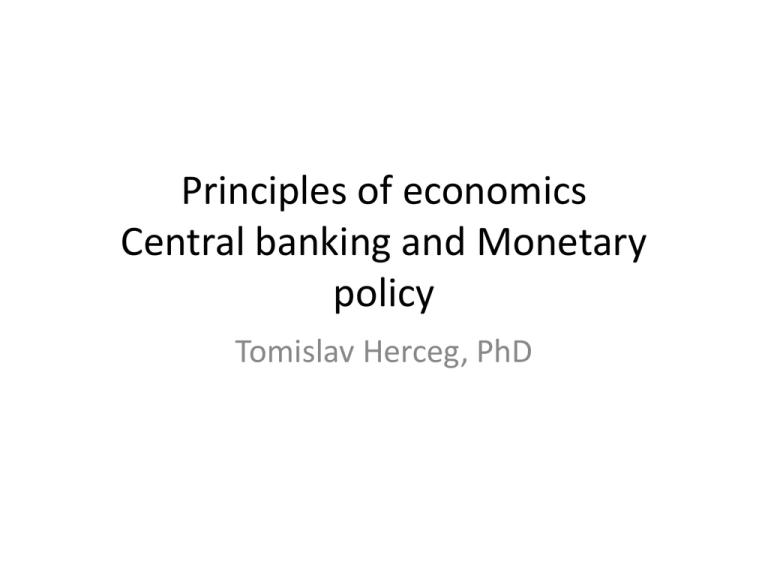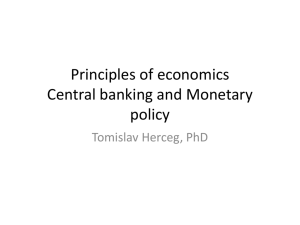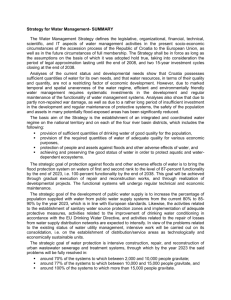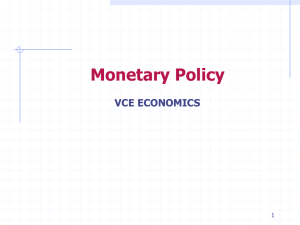Principles of economics Central banking and Monetary policy
advertisement

Principles of economics Central banking and Monetary policy Tomislav Herceg, PhD Central Bank • The most important macroeconomic policy maker • Banks of all the banks, monopolist in the money issue • Croatian National Bank (Hrvatska narodna banka) was founded in 1990. Other central banks: • EU: ECB (European Central Bank) – www.ecb.europa.eu • USA: FED (Federal Reserve District) – www.federalreserve.gov Central bank properties • One of 4 pillars of the state, autonomous towards central government • Council of governors set by the parliament, not by the government • Its activities form national monetary policy • Governed by the Council (for HNB): 1. Executive board – governor and 4 vice governors. 2. External members – 8 councilors Monetary policy • Macroeconomic policy created by the central bank using supply of money management • 3 forms: – Expansive (M grows faster than GDP) – Restrictive (M grows slower than GDP) – Neutral (M grows at the same pace as GDP) Policy objectives of the CB • Economic growth (gy) in line with the economy’s potential to expand • High employment (low u) • Low inflation (Π) • Moderate interest rates (i) CB operations • Open-market operations: buying and selling government securities (bonds and bills) • Discount-rate policy (setting discount rate at which banks can borrow money) • Reserve requirement policy (setting legal requirement on deposits in banks) • Forex operations (buying and selling foreign exchange) => These operations alter supply of money M, in other words, these are tools of monetary policy Open market operations • By buying and selling government bonds and bills supply of money changes: when CB sells bonds, M falls, when CB buys bonds, M rises. • Open market operations are conducted in the REPO auctions. • The most used monetary instrument Discount-Rate policy • CB announces discount rate at which commercial banks can borrow money from CB. • Rarely used in Croatia, banks rather borrow one from another due to tight controls of banks that use CB loans. • Currently at 7% Reserve requirements • By changing reserve rate r monetary multiplier changes: m = 1/r. • Monetary aggregates in Croatia: • M1: cash and deposits on current accounts • M1a: M1 + state deposits • M4: all liquid assets (Mill. HRK) Reserve money Money M1 Money M1a Broadest money M4 Sept. 2014 62.746,1 63.824,1 65.231,6 282.533,6 Open economy monetary policy • Domestic currency is affected by foreign holding of domestic currency. If too much money enters economy central bank has sterilize it by contracting supply of money M. • Exchange rate mechanism is crucial in that process: • Fixed exchange rate: country pegs against other currency at fixed exchange rate and has to adjust its economy so as to keep that rate. • Floating exchange rate: exchange rate freely changes • Operated floated exchange rate (snake in the tunnel): exchange rate floats between certain endpoints HRK/€ • Croatian kuna pegs against Euro in an operated floating exchange regime (mostly between 7.2 HRK and 7.6 HRK per EUR): 7.800000 7.600000 7.400000 7.200000 7.000000 6.800000 6.600000 6.400000 6.200000 1994. 1995. 1996. 1997. 1998. 1999. 2000. 2001. 2002. 2003. 2004. 2005. 2006. 2007. 2008. 2009. 2010. 2011. 2012. 2013. Monetary transmission mechanism • MTM is the route by which changes of money supply M affect output Y, employment E, prices P and inflation Π. • MTM with restrictive monetary policy: 1. Sale of government securities (or increase in the reserve requirement, or sale of foreign currency) 2. Money supply is reduced 3. Interest rates go up 4. Investment falls 5. Reduction of aggregate demand, output and employment and inflation 𝒓 ↑→ 𝑴 ↓→ 𝒊 ↑→ 𝑰, 𝑪, 𝑰𝑴 ↓→ 𝑨𝑫 ↓, 𝒀 ↓, 𝝅 ↓, 𝒖 ↑ Money market • Demand for money is deducted from (a) need to conduct transaction and (b) desire to save • Supply of money is created by CB operations in the commercial bank system • The intercept of L and M determine interest rate i M = supply of money L = demand for money 0 M Money market shifts • Restrictive monetary policy effect i M’ M -money supply contracts -i rises, M falls L 0 M 0 M • Input price rise which causes inflation: i M L’ -L rises L -i rises Monetary transmission mechanism graph (expansive monetary policy) 𝒓 ↓→ 𝑴 ↑→ 𝒊 ↓→ 𝑰, 𝑪, 𝑰𝑴 ↑→ 𝑨𝑫 ↑, 𝒀 ↑, 𝝅 ↑, 𝒖 ↓ i M i M’ Id = investment demand When Y approaches potential output monetary expansion leads only to inflation L I(i) M 0 TE AD’ I 0 Potential output P I AD’ AD AS AD 45° 45° 0 Y 0 I 0 Y Effects of monetary expansion in the long run • Milton Friedman and his monetaristic school of economic thought believe that in the long run monetary expansion leads only to higher level of prices and output goes back to its previous level • Why? Because AS tends to be vertical in the long run and because inflation caused by ME causes a shift of money demand L causing i to rise, thus reducing I and AD and everything goes back. i L’ M L 0 M Phillips curve • Phillips curve shows relation between inflation and unimployment. • In the short run lower unimployment can be „bought” by higher inflation (negatively sloped short run Phillips curve). • Higher inflation leads to rise in interest rates which causes I and thus AD to fall which lifts Phillips curve upwards =>In the long run Phillips curve is equal to the NAIRU – Non Accelerated Inflation Rate of Unemployment π NAIRU = long run Phillips curve short run Phillips curves 0 u Okun’s law • Okun’s law is empirical rule observed in the USA. It says that 1% increase in the unemployment above its natural level (NAIRU) causes a gap between current and potential GDP to increase by 2%. • Natural rate of unemployment is the rate of unemployment at potential level of output. • Cyclical unemployment is the difference between current and natural u. Okun’s law in USA and EU change in unemployment 2 USA: 𝑢𝑡 − 𝑢𝑡−1 = −0,4 𝑔𝑦𝑡 − 3% 1 2 3 GDP growth 2 EU: 𝑢𝑡 − 𝑢𝑡−1 = −1.92(𝑔𝑦𝑡 − 1.75%) 4 Exercise 1 • Liabilities of Croatian National Bank were: IX/2005 Cash 589 Bill. Current account deposits1413 Bill. M1 Share of cash in M1 Find M1 and and share of cash in M1 XI/2007 3194 Bill. 5090 Bill. solution • M1 = cash + current account deposits • Share of cash in M1: Cash/M1 IX/2005 Cash 589 Bill. Current account deposits1413 Bill. M1 2002 Bill. Share of cash in M1 29,42% XI/2007 3194 Bill. 5090 Bill. 8284 Bill. 38,56% Exercise 2: • CNB buys 50 Mill. HRK of national bonds. M1 was 4000 Mill. HRK, cash 1400 Mill. HRK, and required reserves (OR) were 800 Mill. HRK. Calculate: • a) current account deposits • b) required reserve rate • c) money supply mupltiplier • d) new deposits • e) M1 after multiplication proces Solution • M1 = 4000, Cash = 1400, OR = 800 • a) Current account deposits: D = M1 – Cash = 4000 – 1400 = 2600 Bill. HRK • b) Required reserve rate r = OR/D * 100 = 800/2600 * 100 = 30,77% • c) Money supply multiplier • m = 1/r = = 1/0,3077 = 3,25 • d) new deposits ND = m * deposit increase deposits increase = 50 Mill. HRK ND = 3,25×50 = 162,5 Mill. HRK • e) New M1 M1’ = M1 + ND= 4000 + 162,5 = 4162,5 Mill. HRK











